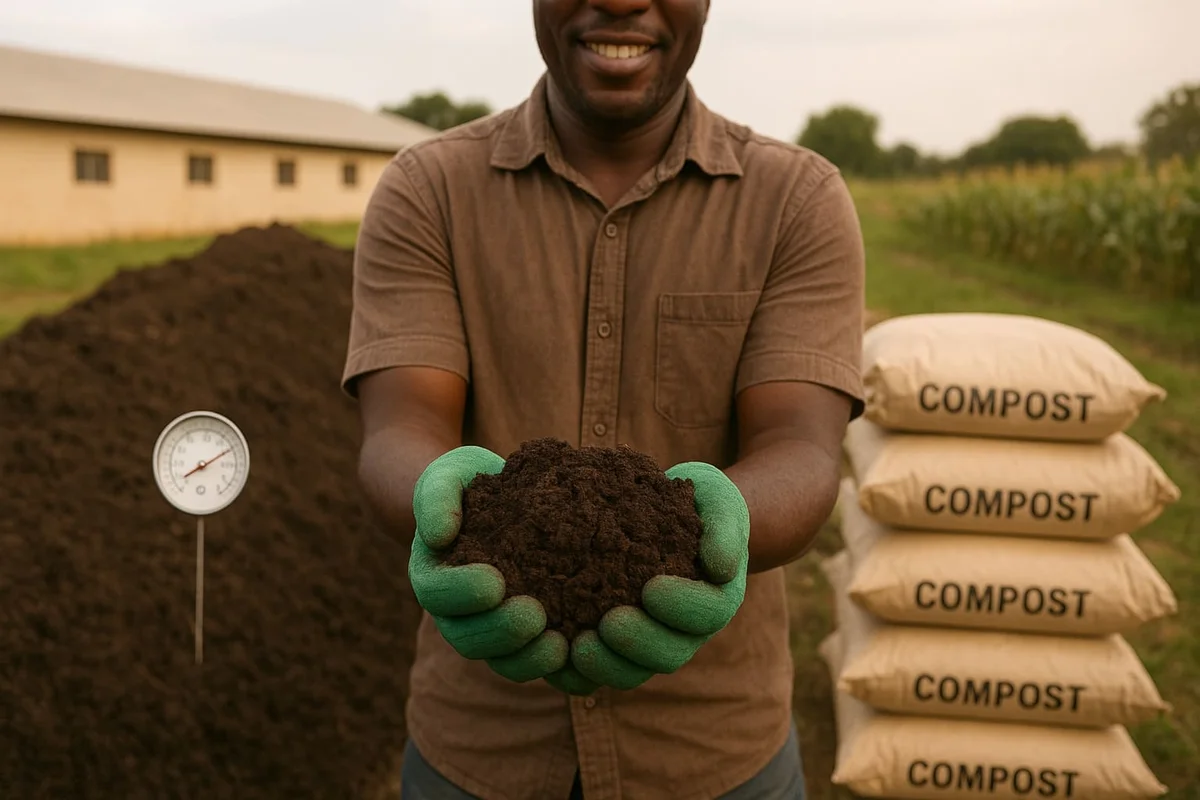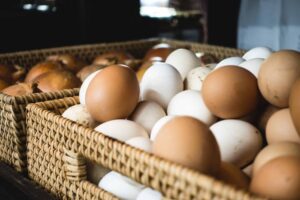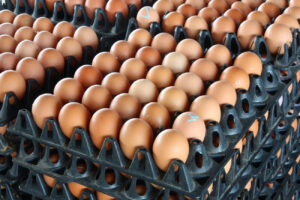Are you a poultry farmer in Nigeria sitting on a pile of what you think is waste? With the rising cost of feed and other inputs, finding new income streams is no longer a luxury—it’s essential for survival. That chicken manure in your pens is actually a pile of money waiting to be made. Many farmers dispose of poultry litter without realizing its massive potential. With the right knowledge, you can turn this farm byproduct into a profitable business stream through value addition. This guide will show you exactly how.
This article explores practical, step-by-step ways to process chicken manure into high-demand products like compost, pelletized fertilizer, and even energy. Based on extensive research and practical experience, our goal is to provide a safe and profitable playbook covering the business models, the science behind safe processing, and how to market your final products to crop farmers across Nigeria. It’s time to stop treating manure as waste and start seeing it as “black gold.”
What Is Value Addition in Poultry Farming?
In simple terms, value addition in poultry farming is the process of taking a raw product, like chicken manure, and turning it into something more valuable and useful. Instead of selling raw, unprocessed manure for a small price, you process it to create standardized, safer, and more effective products that can be sold for a much higher profit. This approach transforms a potential liability into a significant income source for your farm.
Value addition turns raw chicken manure into higher‑value products—tested compost, pelletized fertilizer, organomineral blends, or liquid digestate fertilizer—by meeting safety temperatures and labeling lab‑verified NPK for Nigerian buyers. The goal is to increase your profit margin from the same poultry operation.
Why Not Just Sell Raw Manure?
Selling raw manure is easy, but it leaves a lot of money on the table and comes with several problems: low prices due to inconsistent quality, high transport costs because of water weight, health risks from pathogens, potential crop damage from high ammonia, and the spread of weed seeds. Value addition solves all these issues, allowing you to build a reputable brand and charge a premium price.
How to Make Money from Chicken Manure in Nigeria
Exploring how to make money from chicken manure in Nigeria involves choosing a business model that fits your farm’s scale and investment capacity. From simple composting to more advanced methods like pelletizing or biogas production, each path offers a clear way to turn poultry waste into a valuable commodity. Here are six proven business models with actionable steps.
Bagged, tested compost (PFRP: ≥55°C; windrow ≥15 days with 5 turns)
Composting the mix of manure and bedding materials from your coop is the best starting point. It stabilizes nutrients and kills pathogens and weed seeds. To meet PFRP (Process to Further Reduce Pathogens) standards, maintain ≥55°C: 3 consecutive days for in‑vessel or static‑aerated piles, or 15 days with at least 5 turnings for windrows; log temperatures and turns. Once cured, screen the compost, bag it in 25kg or 50kg sacks, and market it to local farmers.
Pelletized organic fertilizer (label by lab NPK; moisture controlled)
Pelletizing creates a high‑value, easy‑to‑apply product. Dry fully cured compost to ~10–15% moisture, mill to a fine powder, pelletize, then cool and bag. Because pellet mills are capital‑intensive, you might form a cooperative with neighboring farms to share equipment. Always label pellets with batch‑specific, lab‑verified N‑P2O5‑K2O.
Biogas + digestate (market as “liquid digestate fertilizer”; compost solids)
An anaerobic digester converts manure into biogas (for heat/electricity) and digestate. Market the liquid fraction as ‘liquid digestate fertilizer’; dewater and compost the solids for a stable, baggable product.
Organomineral blends for specific crops
Create sophisticated, custom products by blending your composted manure with specific mineral fertilizers. For example, mix compost with Urea for leafy vegetables like Ugu, or with NPK 15-15-15 for fruiting crops like tomatoes. This positions you as an expert and allows you to charge a higher price. Always start with a lab-tested compost base to know your initial nutrient values.
BSF larvae substrate (feed safety and hygiene)
Use chicken manure as a substrate (food) to farm Black Soldier Fly (BSF) larvae. These larvae are a high-protein animal feed that can replace expensive fishmeal or soybean meal. The primary market includes catfish farmers and other poultry producers. This model requires a low initial investment but strict attention to hygiene and feed safety protocols to produce a quality product.
Biochar from poultry litter (pyrolysis; charge with compost)
Biochar is a premium soil conditioner made by heating manure in a low-oxygen environment (pyrolysis). This process creates a lightweight, porous charcoal that improves soil structure and retains water and nutrients for years. After production in a kiln, the biochar should be “charged” by mixing it with compost for a few weeks to load it with nutrients before it’s bagged and sold to horticulturalists and organic farms.
NPK Value of Poultry Manure (and why lab testing matters)
Understanding the NPK value of poultry manure is crucial for marketing your product effectively. The nutrient content can vary greatly, but a lab test provides proof of quality. For accurate results, it is essential to follow correct poultry litter sampling procedures before sending your material for nutrient testing. Typically about 45–75 lb N, 50–80 lb P2O5, and 35–75 lb K2O per wet ton; always lab‑test each batch before labeling or rate calculations. Ranges summarized from extension ‘book values’ and lab datasets.
| Nutrient | Average Value (lb/ton) | Average Value (%) |
|---|---|---|
| Nitrogen (N) | ~60 lb/ton | ~3.0% |
| Phosphate (P₂O₅) | ~65 lb/ton | ~3.25% |
| Potash (K₂O) | ~55 lb/ton | ~2.75% |
| (Note: These values are averages. 1 ton = 2000 lbs) |
In summary, poultry manure typically tests around 2.3–3.8% N, 2.5–4.0% P₂O₅, and 1.8–3.8% K₂O. Lab-testing your batch is the only way to be sure. This allows you to confidently label your product, justify a higher price, and build trust with your customers. To get your manure tested, contact the agricultural department at a local university or search for private soil and plant analysis laboratories in your state. Show a redacted PDF of your latest lab report (moisture, total N, P2O5, K2O) for transparency.
Application Rates in Nigeria: How Many Bags of Chicken Manure per Acre?
A common question from buyers is how many bags of chicken manure per acre they should use. While your lab analysis will offer the best guidance, research from Nigerian trials provides excellent starting points. Evidence from SW Nigeria maize trials shows strong response around 10 t/ha; vegetable trials often test 7.5–15 t/ha with organomineral synergy. For 10 t/ha, apply ≈4.05 t/acre: about 81 bags (50 kg) or 162 bags (25 kg), adjusted to your bag weight and analysis.
Here is a quick conversion table to help your customers:
| Application Rate (t/ha) | Equivalent Rate (tonnes/acre) | 50 kg Bags per Acre | 25 kg Bags per Acre |
|---|---|---|---|
| 5 t/ha | ~2.02 t/acre | ~40 bags | ~80 bags |
| 10 t/ha (Maize) | ~4.05 t/acre | ~81 bags | ~162 bags |
| 15 t/ha (Vegetables) | ~6.07 t/acre | ~121 bags | ~242 bags |
(Note: 1 hectare = 2.47 acres. Source: SW Nigeria maize trials; cucumber trial with organomineral synergy.)
Disadvantages of Chicken Manure Fertilizer (and how to mitigate)
Being transparent about the disadvantages of chicken manure fertilizer (in its raw form) helps you sell your processed product as the solution. Raw manure can carry pathogens and cause ammonia/salt burn; repeated N‑based use can overload soil P—use thermophilic composting, soil tests, and responsible rates. Your value-added products directly mitigate these issues. Properly managed thermophilic composting is the most effective tool, significantly reducing risks and creating a superior, safer product.
Here’s a breakdown of the risks and how composting mitigates them:
- Pathogens (E. coli, Salmonella): The high temperatures (≥55°C) of thermophilic composting significantly reduce these harmful bacteria and improve hygiene.
- Ammonia Burn: Composting stabilizes nitrogen into a slow-release form that won’t burn plant roots.
- Weed Seeds: The sustained heat of composting destroys most viable weed seeds.
- Salt Content & Phosphorus Buildup: Composting helps, but the best mitigation is advising farmers on proper application rates based on regular soil testing.
- Antibiotic Residues: Proper thermophilic composting reduces pathogens and mitigates many antibiotic‑resistance risks; however, some ARGs can persist, so plan for full curing, good hygiene, and periodic testing.
From Product to Profit: Marketing Your Manure Business
Once you have a quality product, you need a solid marketing strategy. Start by identifying your target customers—local crop farmers, horticulturalists, or garden supply stores. To treat this as a serious venture, you should create a business plan that outlines your production costs, pricing, and sales strategy. Build a reputation for quality and consistency by sharing your lab test results. Good packaging, clear labeling with NPK values, and offering delivery can set you apart from competitors.
Compliance and Labeling in Nigeria (NFQC Act, 2019; NESREA basics)
If you package and sell fertilizers or organomineral blends in Nigeria, register/label under the National Fertilizer Quality (Control) Act, 2019 (via FMAFS/FISSD); NESREA covers environmental compliance. Keep a simple log of date/time/temperature and turning events to demonstrate PFRP compliance if inspected.
FAQs
What is value addition in poultry farming?
Value addition means processing raw poultry manure into more profitable, safer, and standardized products like bagged compost, pelletized fertilizer, or biogas, which increases its market value.
How many bags of chicken manure per acre?
A common rate for maize is 10 tonnes per hectare, which is about 81 bags (50 kg) per acre, but this depends on the crop and manure analysis from a lab test.
What are the disadvantages of chicken manure fertilizer?
The main risks from raw manure are pathogens, crop burn from ammonia, weed seeds, and excess phosphorus over time; these are all managed effectively through proper composting.
What is the NPK value of poultry manure?
It varies widely, but a general range is 2.3–3.8% Nitrogen (N), 2.5–4.0% Phosphate (P2O5), and 1.8–3.8% Potash (K2O); it is essential to lab-test each batch for accuracy.
Conclusion
The message is clear: the chicken manure on your farm is not a problem to be managed, but a resource to be monetized. By embracing the principles of value addition—through composting, pelletizing, biogas production, or creating other high-value products—you can create a significant new revenue stream for your poultry business. This approach not only boosts your bottom line but also contributes to a more sustainable agricultural system in Nigeria by recycling nutrients and reducing waste.
Start small, perfect your process, and build a reputation for quality. The path from poultry waste to wealth is achievable, and it begins with a shift in perspective. Your farm’s “black gold” is waiting.

Oladepo Babatunde is the founder of ChickenStarter.com. He is a backyard chicken keeper and educator who specializes in helping beginners raise healthy flocks, particularly in warm climates. His expertise comes from years of hands-on experience building coops, treating common chicken ailments, and solving flock management issues. His own happy hens are a testament to his methods, laying 25-30 eggs weekly.



